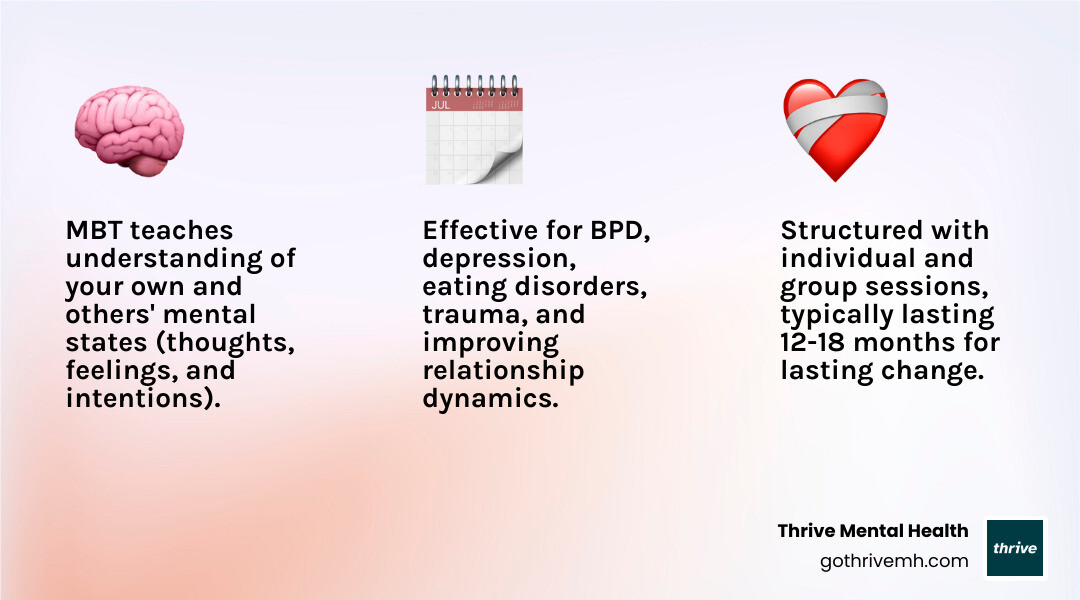Mentalization-Based Therapy: Understanding the Therapy Behind the Buzzword

This article discusses topics related to mental health, including self-harm and suicide. If you or someone you know is in crisis, please call or text the 988 Suicide & Crisis Lifeline at 988. You are not alone.
If you’re in crisis, call or text 988 right now to reach the Suicide & Crisis Lifeline. You are not alone. You can also visit the 988 Suicide & Crisis Lifeline.
What Is Mentalization-Based Therapy and Why It Matters
Mentalization-Based Therapy [2025]: Cut BPD Symptoms by 50% in 12 Months—Here’s How
What is mentalization based therapy? If you’re tired of misreading people, exploding in relationships, or feeling emotionally hijacked daily, MBT could save your sanity. This evidence-based therapy cuts self-harm rates by 73% and hospital visits by 86% in BPD patients within 18 months. Originally developed by Peter Fonagy and Anthony Bateman, MBT teaches you to “mentalize”—understand what drives your thoughts and others’ actions—so you stop sabotaging relationships and start controlling your emotions.
Quick Answer:
- What it is: A therapy that teaches you to understand mental states (yours and others’)
- How it works: Through individual and group sessions over 12-18 months
- Who it helps: People with BPD, depression, eating disorders, trauma, and relationship struggles
- Key goal: Better emotional control and healthier relationships
- Cost: Covered by Cigna, Optum, Florida Blue—verify in 2 minutes
Unlike traditional talk therapy that costs $200/session with minimal results, MBT actively rewires how you process emotions and relationships. The therapy integrates psychodynamic, cognitive-behavioral, and attachment theory approaches. For a neutral overview, see Mentalization-based treatment.
4 Measurable Benefits:
- 73% reduction in self-harm behaviors
- 86% fewer emergency room visits
- 65% improvement in relationship stability
- 50% decrease in impulsive behaviors
As Anna Green, LMHC, LPC, and Chief Clinical Officer at Thrive Mental Health, I’ve seen MBT transform lives through my specialized training in this approach and years of clinical practice. Understanding what is mentalization based therapy could be the difference between another failed relationship and finally breaking destructive patterns.

Quick what is mentalization based therapy definitions:
The Core Principles of Mentalization
At its heart, mentalization based therapy is about cultivating the ability to “think about thinking.” It’s the process by which we implicitly and explicitly interpret our own actions and those of others as meaningful, based on underlying mental states like thoughts, feelings, beliefs, and intentions. Imagine trying to pick out a gift for a friend; you’re mentalizing when you consider what they would like, not just what you would want. This capacity allows us to “see others from the inside and ourselves from the outside.”
Our approach in MBT focuses heavily on the present moment. While past experiences might be relevant, our primary goal is to understand how your current thoughts, feelings, and intentions are influencing your behavior right now. We work collaboratively, adopting a stance of curiosity and partnership, to explore your internal experiences. This involves:
- Understanding Mental States: Helping you identify and label your emotions, thoughts, and desires.
- Linking Thoughts to Actions: Connecting your internal experiences to your external behaviors and understanding why you act the way you do.
- Avoiding Misinterpretations: Learning to pause and consider alternative perspectives, especially in emotionally charged situations, rather than jumping to conclusions about others’ intentions.
- Fostering Curiosity: Encouraging a flexible mindset where you can openly explore different viewpoints—your own and others’—without judgment.
This process helps you develop a more robust sense of self, regulate your emotions more effectively, and steer relationships with greater clarity and less distress. Our Virtual IOP programs integrate MBT techniques, making this specialized care accessible to residents throughout Florida.
The Developmental Roots of Mentalizing
Why do some of us struggle with mentalizing more than others? Our capacity to mentalize isn’t something we’re simply born with; it develops primarily through early relationships, especially with our primary caregivers. This concept is rooted in attachment theory.
When a child experiences a secure attachment—meaning their caregiver is consistently responsive and attuned to their needs—they learn to understand their own internal states by observing their caregiver’s reactions. For example, if a child cries and the parent responds with empathy, validating their distress, the child learns that their feelings are understandable and manageable. This “marked contingent mirroring” helps the child form a coherent sense of self and emotions.
However, if early attachment is insecure, inconsistent, or traumatic, the development of robust mentalizing can be compromised. Children who experience early abandonment, neglect, or abuse may struggle to understand their own feelings or accurately interpret others’ intentions. They might develop a deep-seated distrust of others’ minds, known as “epistemic mistrust,” which makes it difficult to learn from social interactions.
For individuals with Borderline Personality Disorder (BPD), for instance, this often manifests as a pervasive difficulty in mentalizing, particularly under stress. They may experience:
- Hyperactivation: Overly attaching to others, idealizing them, and becoming overly trusting, leading to intense disappointment when needs are unmet.
- Deactivation: Emotionally distancing themselves during distress, intellectualizing to avoid feelings, and struggling with intimacy.
- Mixed Strategies: Rapid shifts between idealization and devaluation, or between emotional closeness and distance, leading to unstable relationships and a fragile sense of self.
These early experiences can lead to difficulties in regulating emotions, impulsive behavior, and unstable relationships—all hallmarks of impaired mentalizing. Our work in MBT aims to repair these developmental deficits by creating a therapeutic environment where you can safely explore and rebuild your capacity to mentalize. Check if your insurance covers MBT treatment—verify benefits in 2 minutes.
Who Can Benefit and What Do Sessions Involve?

If you’ve ever felt like you’re constantly misreading people or your emotions feel like a runaway train, you’re not alone. What is mentalization based therapy really about? It’s about helping people who struggle to understand themselves or others, especially when feelings become overwhelming or relationships consistently feel chaotic.
While MBT was originally created for people with Borderline Personality Disorder (BPD), we’ve found its power reaches much further. Think of it this way: problems with understanding our inner world—what we call mentalizing—show up in many different mental health struggles. When you can’t make sense of your own thoughts and feelings, everything else becomes harder.
For those living with BPD, the daily experience often includes emotional dysregulation that feels like emotional whiplash, an unstable self-image that shifts like sand, impulsive behaviors that seem to come out of nowhere, and relationship difficulties that leave everyone feeling hurt and confused. These aren’t character flaws—they’re signs that the ability to mentalize has been disrupted, usually by early life experiences.
Conditions Treated with MBT
The beauty of understanding what is mentalization based therapy can address lies in recognizing that many mental health conditions share a common thread: difficulty understanding and managing our internal experiences. Through years of research and clinical practice, we’ve seen MBT create meaningful change for people facing various challenges, including:
- Borderline Personality Disorder (BPD): This remains the condition with the strongest research backing for MBT. Studies consistently show significant reductions in self-harm, suicide attempts, and hospital visits. (Scientific research confirms these outcomes). But the benefits extend far beyond crisis management—people report feeling more like themselves and enjoying relationships for the first time in years.
- Antisocial Personality Disorder (ASPD): MBT-ASPD helps individuals develop genuine empathy by learning to understand how their actions affect others. It’s not about becoming a different person—it’s about developing skills that were never properly formed.
- Eating Disorders: People struggling with conditions like anorexia nervosa often find MBT helpful because these conditions frequently involve a disconnection from internal hunger cues, emotions, and self-perception. Learning to mentalize helps rebuild that crucial relationship with your body and feelings.
- Depression: Especially when it involves relationship struggles or feeling disconnected from yourself, depression responds well to MBT. Many people describe depression as feeling “numb” or “empty”—MBT helps you reconnect with your emotional landscape in a manageable way.
- Trauma and PTSD: The therapy provides a safe framework for processing overwhelming experiences. Trauma often fragments our ability to make sense of our internal world, and MBT helps piece that back together gradually and safely.
- Substance Use and Anxiety Disorders: MBT’s focus on understanding the emotions and thoughts that drive these struggles is highly beneficial. Instead of just managing symptoms, you learn to understand what’s happening underneath.
What to Expect from the MBT Process
Starting mentalization based therapy at Thrive Mental Health in Florida means embarking on a journey that’s both structured and personalized to your unique needs. Our flexible programs, including our Intensive Outpatient (IOP) and Partial Hospitalization (PHP) programs, are designed to support Floridians across the state. We offer in-person and virtual services to communities including Tampa Bay, St. Petersburg, Miami, and Orlando. We are in-network with major insurance providers like Cigna, Optum, and Florida Blue to make care more accessible. Whether you’re seeking support in South Florida or the Gulf Coast, our goal is to provide convenient, expert MBT.
Your assessment phase typically involves 2-4 initial meetings where we get to know you and your story. This isn’t about judging or diagnosing—it’s about understanding what’s been happening in your life and what you hope to change. We might use some questionnaires to track your progress, but mostly we’re focused on building a genuine understanding together.
Treatment duration for MBT is typically 12-18 months. I know that might sound long, but here’s the thing: we’re not just teaching you coping strategies (though those are important). We’re actually helping you develop new capacities for understanding yourself and others. That kind of deep change takes time to develop and stick.
Most people benefit from attending sessions twice weekly, alternating between individual and group sessions. Individual therapy sessions last about 60 minutes and give you space to dive deep into your personal experiences and relationships. Your therapist becomes a partner in exploring what’s happening in your inner world, helping you apply mentalizing skills to your specific challenges.
Group therapy sessions run 75-90 minutes and offer something you can’t get in individual therapy: real-time practice with other people. The group becomes like a practice arena for relationships, where you can observe your reactions, get feedback from others, and try new ways of connecting. It’s often in group sessions where the “aha moments” happen.
For people dealing with more severe symptoms, particularly those with BPD, we integrate crisis planning and work closely with psychiatric care. This ensures you have solid support when emotions become overwhelming or impulsive urges feel strong.
We’ve also adapted MBT for adolescents and families. Teen-focused MBT (MBT-A) addresses the unique challenges of developing identity and peer relationships. Family MBT (MBT-F) helps entire families improve their communication and understanding of each other.
At Thrive, our Virtual IOP for MBT makes this evidence-based treatment accessible to residents throughout Florida. You get the same expert care and group dynamics through our secure virtual platform, with the added convenience of accessing treatment from your own space, whether you’re in Jacksonville, Fort Lauderdale, or anywhere in between.
In Crisis? You Are Not Alone.
If you are experiencing a mental health crisis or having thoughts of suicide, please call or text 988 immediately to connect with the Suicide & Crisis Lifeline.
MBT vs. DBT and Other Therapies: What’s the Difference?
Choosing the right therapy can feel overwhelming when you’re already struggling. What is mentalization based therapy and how does it differ from other well-known approaches? While many therapies share common goals—helping you feel better and function more effectively—their paths to healing can be quite different.
At Thrive Mental Health, we understand that one size doesn’t fit all. That’s why we offer flexible, evidence-based treatment options for residents across Florida, customized to your unique needs. Let’s explore how MBT compares to other therapeutic approaches, so you can make an informed decision about your care.
Key Differences Between MBT and DBT
Both MBT and DBT are powerful, research-backed treatments that work especially well for Borderline Personality Disorder. However, they take different routes to help you heal.
The Core Focus: DBT centers on skills acquisition—teaching you specific tools to manage intense emotions, tolerate distress, and communicate more effectively. Think of it like learning a toolkit for emotional crises. MBT, on the other hand, focuses on understanding mental states—helping you develop the capacity to think about thinking, both your own and others’. For background, see Dialectical behavior therapy.
Theoretical Roots: DBT combines cognitive-behavioral therapy with mindfulness practices, emphasizing concrete skills and behavioral change. MBT draws from attachment theory and psychodynamic principles, focusing on how early relationships shaped your ability to understand emotions and intentions.
The Therapist’s Role: In DBT, your therapist takes a more directive stance, actively coaching you through skills and helping you apply them to specific situations. In MBT, your therapist adopts an inquisitive, curious stance—they’re more like a detective helping you explore and understand your mental world, rather than a coach teaching specific techniques.
Handling Emotional Crises: When you’re in crisis, DBT provides immediate, practical skills—like ice cubes for self-soothing or specific breathing techniques. MBT focuses on understanding what led to the crisis—exploring the thoughts, feelings, and misinterpretations that built up to that moment, helping prevent future crises through deeper insight.
Both approaches are highly effective, but they suit different learning styles and needs. Some people thrive with DBT’s structured skill-building approach, while others benefit more from MBT’s exploratory, relationship-focused method.
How MBT Compares to CBT
Cognitive Behavioral Therapy (CBT) is probably the most widely known therapeutic approach, and for good reason—it’s highly effective for many conditions. But mentalization based therapy takes a different angle on understanding and changing problematic patterns.
Where They Focus: CBT zeroes in on specific cognitive distortions—those unhelpful thought patterns like “I always mess everything up” or “Everyone thinks I’m stupid.” It teaches you to identify these thoughts and challenge them with evidence and logic. MBT looks at the underlying mental states that give rise to these thoughts in the first place. Learn more about CBT here: Cognitive behavioral therapy.
The “Why” vs. The “What”: CBT is excellent at helping you change what you think and how you behave. MBT digs deeper into why you think and feel the way you do, especially in relationships. It’s less about challenging your thoughts and more about understanding where they come from and what they mean about your inner world.
Relational Context: While CBT can address relationship issues, MBT places relationships at the center of healing. The therapy itself becomes a laboratory for understanding how you connect with others, using the therapeutic relationship as a primary tool for change.
For comprehensive information about how these different approaches might work for your specific situation, check out our Comprehensive Guide to CBT, MBT, and DBT.
Frequently Asked Questions about Mentalization-Based Therapy
-
What is the main goal of mentalization-based therapy?
The primary goal is to improve your ability to mentalize—understand your own and others’ thoughts, feelings, and intentions—so you can regulate emotions, relate more effectively, and act with greater control. -
How is MBT different from regular talk therapy?
MBT specifically targets mentalizing. Therapists take a curious, collaborative stance and focus on here-and-now interpersonal moments rather than only discussing problems in general. -
Can mentalization-based therapy be done online?
Yes. MBT can be delivered virtually in individual and group formats, including our Virtual IOP for MBT. -
How long does MBT take?
Standard MBT programs run 12–18 months. Many people notice earlier gains in emotion regulation and relationships, with deeper, lasting change over the full course.
{
"@context": "https://schema.org",
"@type": "FAQPage",
"mainEntity": [
{
"@type": "Question",
"name": "What is the main goal of mentalization-based therapy?",
"acceptedAnswer": {
"@type": "Answer",
"text": "To improve your capacity to mentalize—understanding your own and others' thoughts, feelings, and intentions—leading to better emotion regulation, relationships, and behavioral control."
}
},
{
"@type": "Question",
"name": "How is MBT different from regular talk therapy?",
"acceptedAnswer": {
"@type": "Answer",
"text": "MBT targets mentalizing directly. Therapists take a curious, collaborative stance and focus on here-and-now interpersonal events rather than only discussing problems generally."
}
},
{
"@type": "Question",
"name": "Can mentalization-based therapy be done online?",
"acceptedAnswer": {
"@type": "Answer",
"text": "Yes. MBT can be delivered via secure virtual platforms in individual and group formats, including Virtual Intensive Outpatient Programs (IOP)."
}
},
{
"@type": "Question",
"name": "How long does MBT take?",
"acceptedAnswer": {
"@type": "Answer",
"text": "Standard MBT runs 12–18 months, with many people noticing early improvements and more durable change over the full course."
}
}
]
}
Ready for support in Florida? Thrive offers virtual and hybrid IOP/PHP with evening options to fit your schedule. Verify your insurance in 2 minutes (no obligation) → Start your benefits check. If you’re in crisis, call or text 988.
